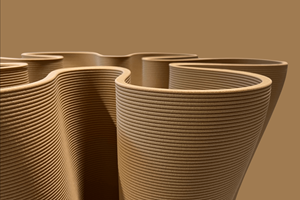Beyond Gravity announces maiden flight of Vega-C rocket, features CFRP composites
Vega-C replaces the current Vega rocket, comprising a CFRP payload fairing and payload adapter system, as well as a more intuitive onboard computer, all of which is produced at Beyond Gravity’s various production sites.
Artist’s view of Vega-C on the launch pad. Photo Credit: ESA–J. Huart
(formerly RUAG Space, Zürich, Switzerland) has delivered the composite payload fairing, the top of the new medium-lift European rocket Vega-C, which launches on July 13 for its inaugural flight. Beyond Gravity also produced the launcher computer and the Vampire payload adapter system, the latter of which also uses carbon fiber-reinforced polymer (CFRP) composites.
Vega-C is scheduled to lift off from the European spaceport in Kourou, South America, launching the company’s “” Laser Relativity satellite. The spherical satellite enables research into geodynamics and general relativity, Beyond Gravity says.
“The first flight of a new rocket is always a very special moment. We have delivered mission-critical products to the rocket with our payload fairing, our payload adapter system and the launcher’s onboard computer,” André Wall, CEO, Beyond Gravity, says. “Each product is customized for this new rocket and has new, enhanced features.” Vega-C replaces the current Vega rocket.
The top of the Vega-C rocket, the payload fairing, has a new design. “The fairing is larger than the fairing of the Vega rocket and can accommodate an additional payload mass of 800 kilograms,” Holger Wentscher, senior vice president, Launchers at Beyond Gravity, explains. “Additionally, our fairing includes state-of-the-art technologies that make it more versatile than its predecessor.” This also results in reduced launch costs per kilogram, the company says.
The two halves of the Beyond Gravity payload fairings for Vega-C (left) and the “Vampire” payload adapter system from Beyond Gravity (right) in a cleanroom in Kourou. Photo Credit: Beyond Gravity
The ogive-shaped fairing at the top of Vega-C protects the satellites from thermal, acoustic and aerodynamic environment at launch and on the ascent to space. The 9-meter-high fairing with a diameter of 3.3 meters was produced at Beyond Gravity’s site in Emmen, Switzerland. The fairing is made of CFRP composites that were cured in an industrial oven. All payload fairings for any European rocket are said to comes from Beyond Gravity and this production facility.
Vega-C can be used for one, two or more payloads (satellites) per launch. To place a larger single satellite into space, Vega-C uses a payload adapter system called “Vampire.” “We have developed a new design for this adapter, which makes it possible to utilize the maximum performance of the Vega-C launcher. Our adapter makes sure, that the satellite is safely placed into orbit with [the] highest precision,” stresses Wentscher. All payload adapters and separations system from Beyond Gravity are produced at its site in Linköping, Sweden. The Vampire adapter will be used for single large payloads and can be used in combination with smaller payloads on the SSMS (Small Spacecraft Mission Service) multiple payload dispenser.
Moreover, during flight, the Vega-C launcher is controlled by an onboard computer (“brain”) from Beyond Gravity. “We have developed a new and improved version of our onboard computer, which is smaller, lighter and more cost efficient,” Wentscher says. The launcher onboard computer is being built at Beyond Gravity’s site in Gothenburg. Beyond Gravity also provided all computers for the Vega rockets.
Related Content
Carbon fiber composite pallet revolutionizes freight industry
LOG Point Pallet fuses advanced materials with innovative design and manufacturing to improve supply chains worldwide.
Read MoreLow-cost, efficient CFRP anisogrid lattice structures
CIRA uses patented parallel winding, dry fiber, silicone tooling and resin infusion to cut labor for lightweight, heavily loaded space applications.
Read MoreSulapac introduces Sulapac Flow 1.7 to replace PLA, ABS and PP in FDM, FGF
Available as filament and granules for extrusion, new wood composite matches properties yet is compostable, eliminates microplastics and reduces carbon footprint.
Read MoreComposites end markets: New space (2025)
Composite materials — with their unmatched strength-to-weight ratio, durability in extreme environments and design versatility — are at the heart of innovations in satellites, propulsion systems and lunar exploration vehicles, propelling the space economy toward a $1.8 trillion future.
Read MoreRead Next
NASA reveals James Webb Telescope’s first images of an unseen universe
The world gets its first look at the full capabilities of the composites-intensive James Webb Space Telescope in space through a series of highly detailed images.
Read MoreCeramic matrix composites: Faster, cheaper, higher temperature
New players proliferate, increasing CMC materials and manufacturing capacity, novel processes and automation to meet demand for higher part volumes and performance.
Read MoreNext-gen fan blades: Hybrid twin RTM, printed sensors, laser shock disassembly
MORPHO project demonstrates blade with 20% faster RTM cure cycle, uses AI-based monitoring for improved maintenance/life cycle management and proves laser shock disassembly for recycling.
Read More












